Getting Started with Trailing Plants Indoors
You’ve got a space to transform, so let’s style trailing plants with ease. Start by picking the right spot; aim for areas with indirect light, like near a north-facing window with 4-6 hours of brightness daily. Trailing plants, such as pothos or string of pearls, cascade beautifully when positioned high. Curious about the best ways to display them? Stick around for practical tips to elevate your setup.
Contents
- 1 Choose the Right Hanging Planters
- 2 Utilize Wall-Mounted Shelves
- 3 Create a Cascading Window Display
- 4 Incorporate Trailing Plants on Bookshelves
- 5 Use Plant Stands for Height Variation
- 6 Mix Different Textures and Colors
- 7 Hang Plants From Ceiling Hooks
- 8 Style With Decorative Macrame Hangers
- 9 Place on High Furniture for Drama
- 10 Group Plants for a Lush Effect
Choose the Right Hanging Planters
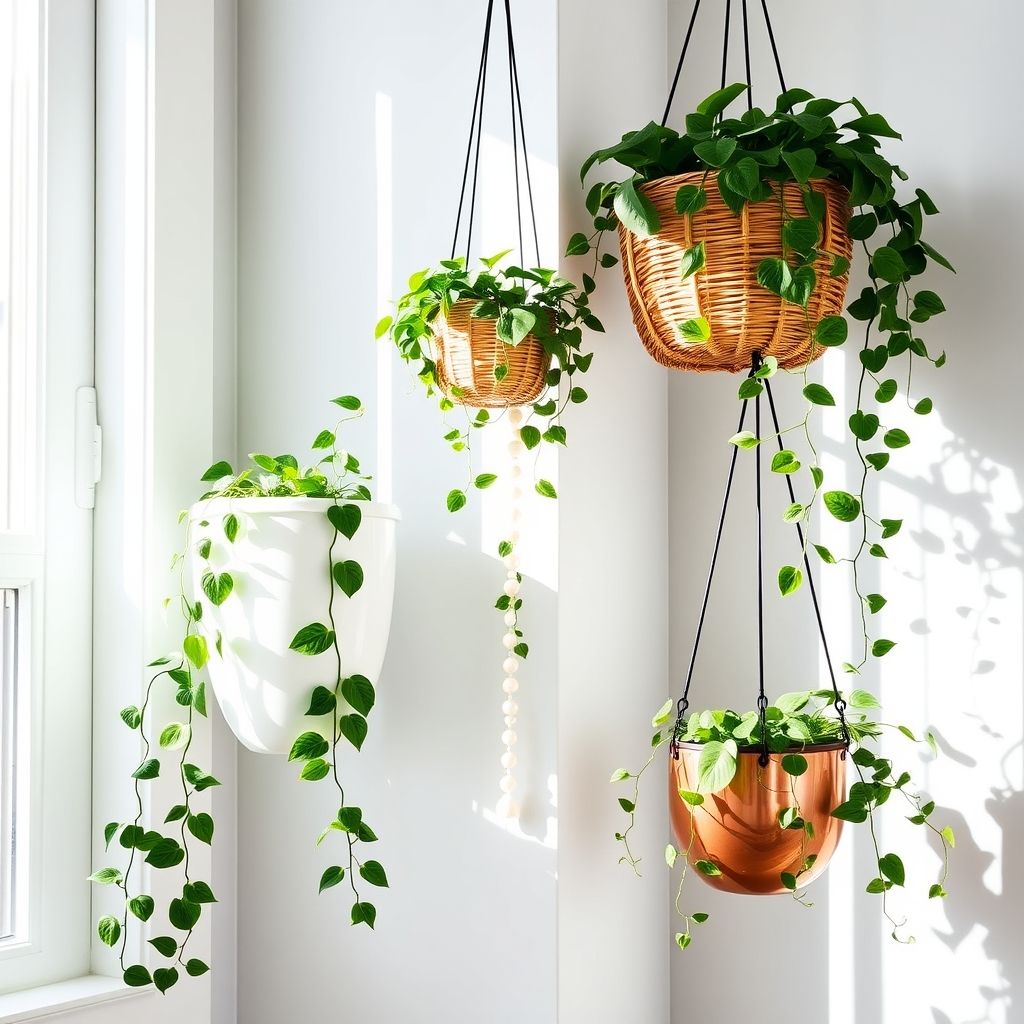
Choosing the right hanging planters for trailing plants is essential to both their health and the overall aesthetic of your indoor space. The planter should complement the plant’s growth habits, providing enough room for roots to spread while guaranteeing proper drainage to prevent waterlogging. Opt for materials like ceramic, terracotta, or lightweight plastic, depending on your style preference and the weight capacity of your hanging setup. Additionally, consider planters with built-in drainage holes or trays to manage excess water and protect your floors or furniture.
When selecting a hanging planter, think about the location and the type of trailing plant you’re styling. For instance, plants like pothos or string of pearls thrive in hanging baskets that allow their vines to cascade freely, while macrame hangers or wall-mounted planters can add a bohemian or modern touch to your decor. Guarantee the planter’s size matches the plant’s needs—too small, and the roots may become cramped; too large, and the soil may retain too much moisture, risking root rot. Also, prioritize sturdy hanging mechanisms, such as strong hooks or chains, to safely support the weight of the planter and plant over time.
Lastly, don’t overlook the visual impact of the planter itself. Choose colors and textures that harmonize with your interior design, whether it’s a minimalist white pot for a clean look or a woven basket for a cozy, natural vibe. Mixing and matching different planter styles can create a dynamic display, especially when grouping multiple trailing plants at varying heights. By thoughtfully selecting hanging planters, you can elevate both the health of your plants and the beauty of your indoor environment.
Utilize Wall-Mounted Shelves
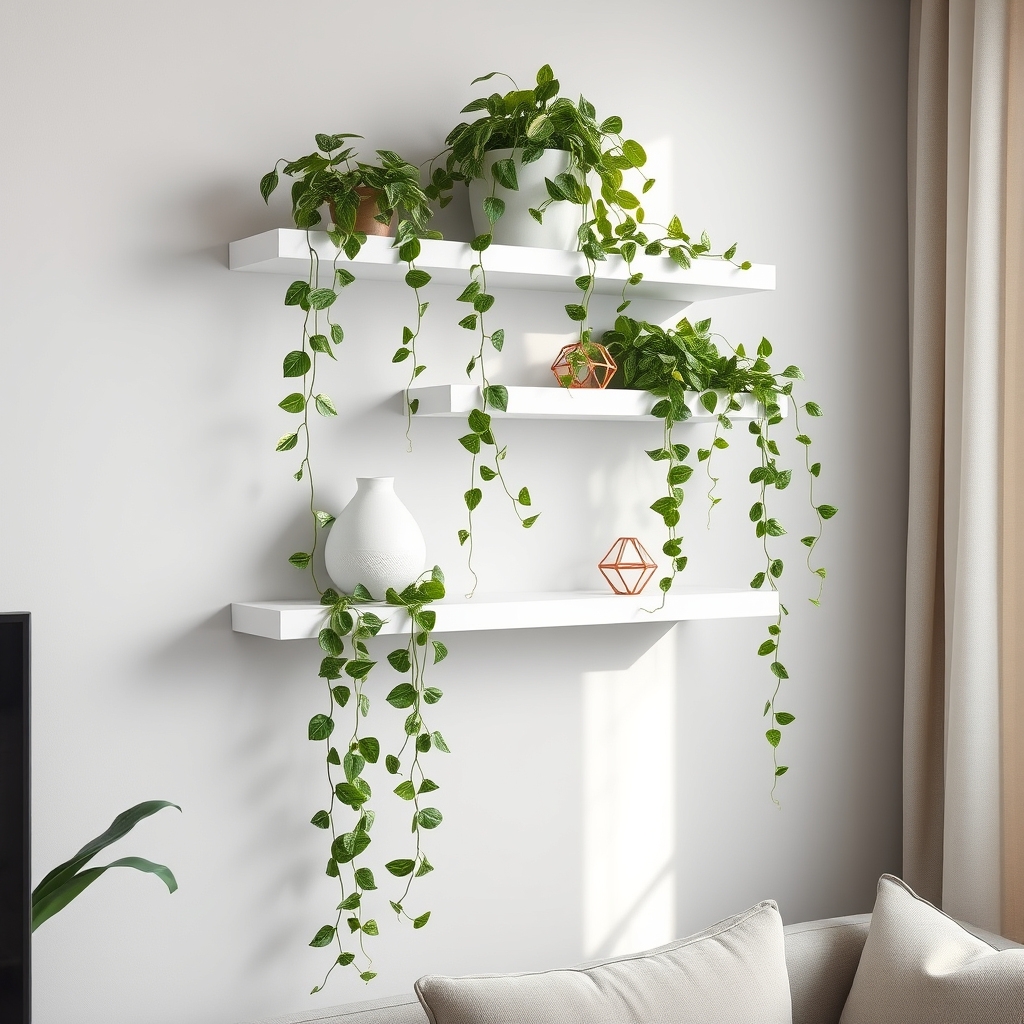
Wall-mounted shelves are an excellent way to style trailing plants indoors, as they provide a vertical display that maximizes space while adding a dynamic visual element to your home. By installing shelves at varying heights on your walls, you can create a cascading effect with trailing plants like pothos, string of pearls, or ivy. This setup not only showcases the natural beauty of the plants as they drape over the edges but also keeps them out of reach of pets or children if needed.
Choose shelves with a minimalist design to keep the focus on the plants, or opt for decorative ones to complement your interior style. Position the shelves near a window to ensure the plants receive adequate light, but be mindful of their specific care needs—some trailing plants thrive in indirect light, while others may need brighter conditions. You can also mix in small decor items like candles or books on the shelves to create a balanced, curated look without overcrowding the space.
For added creativity, consider staggering the shelves in an asymmetrical pattern to mimic the organic flow of the trailing vines. This approach adds depth and interest to your walls, transforming them into a living piece of art. Regularly trim and care for the plants to maintain their shape and prevent them from becoming too heavy for the shelves, guaranteeing both safety and aesthetic appeal.
Create a Cascading Window Display
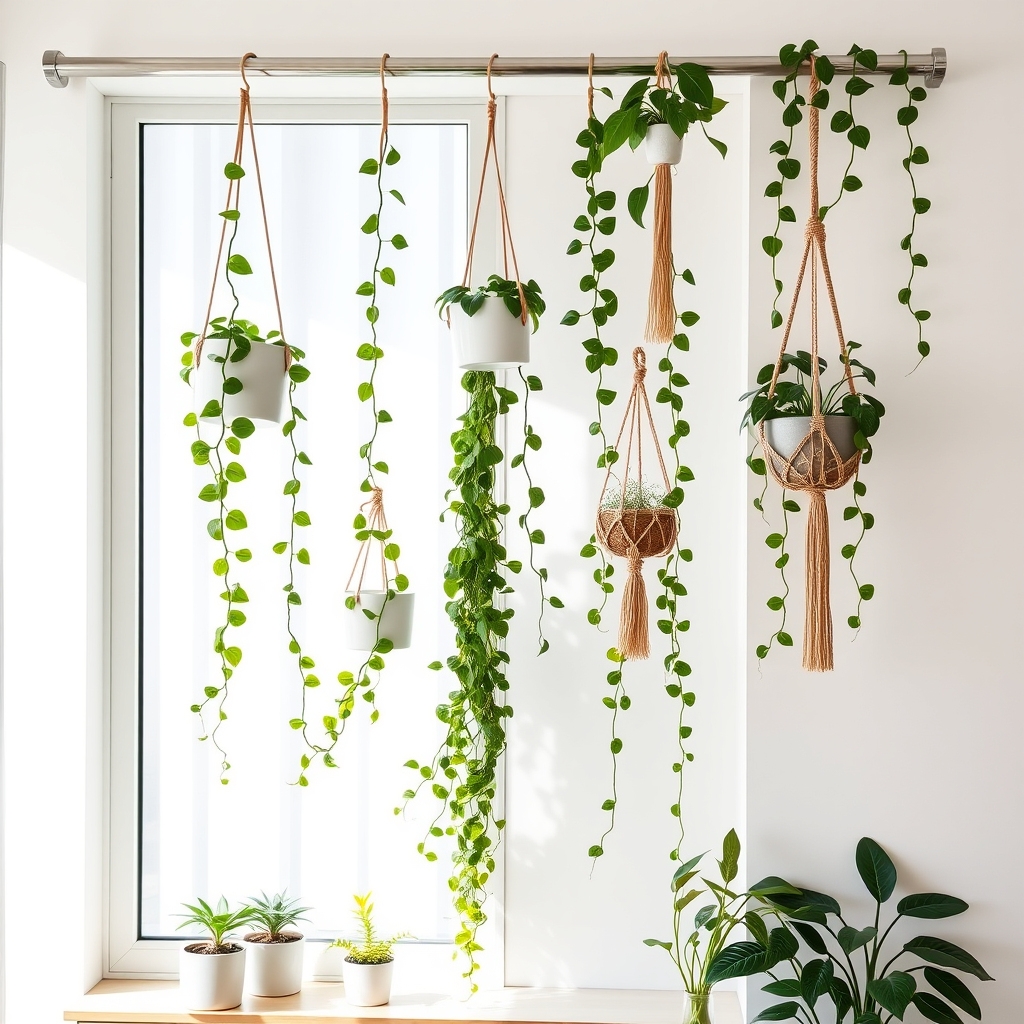
Creating a cascading window display with trailing plants is a stunning way to bring life and greenery into your indoor space. Choose a window with ample natural light, as most trailing plants like pothos, string of pearls, or ivy thrive in bright, indirect sunlight. Install a sturdy curtain rod or tension rod above the window frame, making sure it can support the weight of the plants and their pots. Hang lightweight planters or macramé holders from the rod, positioning them at varying heights to create a dynamic, layered effect that mimics a natural waterfall of foliage.
Select trailing plants with different textures and colors to add visual interest to your display. For instance, combine the delicate, bead-like leaves of a string of pearls with the broad, heart-shaped leaves of a philodendron. Make sure the pots have proper drainage to prevent water from pooling, and place saucers or trays beneath to catch any drips. Regularly rotate the plants or adjust their positions to make sure even light exposure, promoting balanced growth.
Water and care for your plants according to their specific needs, as overwatering can be a common issue in hanging displays. Trim any dead or overgrown vines to maintain a neat appearance and encourage fuller growth. This cascading window display not only enhances the aesthetic of your room but also maximizes vertical space, making it ideal for small apartments or areas with limited floor space.
Incorporate Trailing Plants on Bookshelves
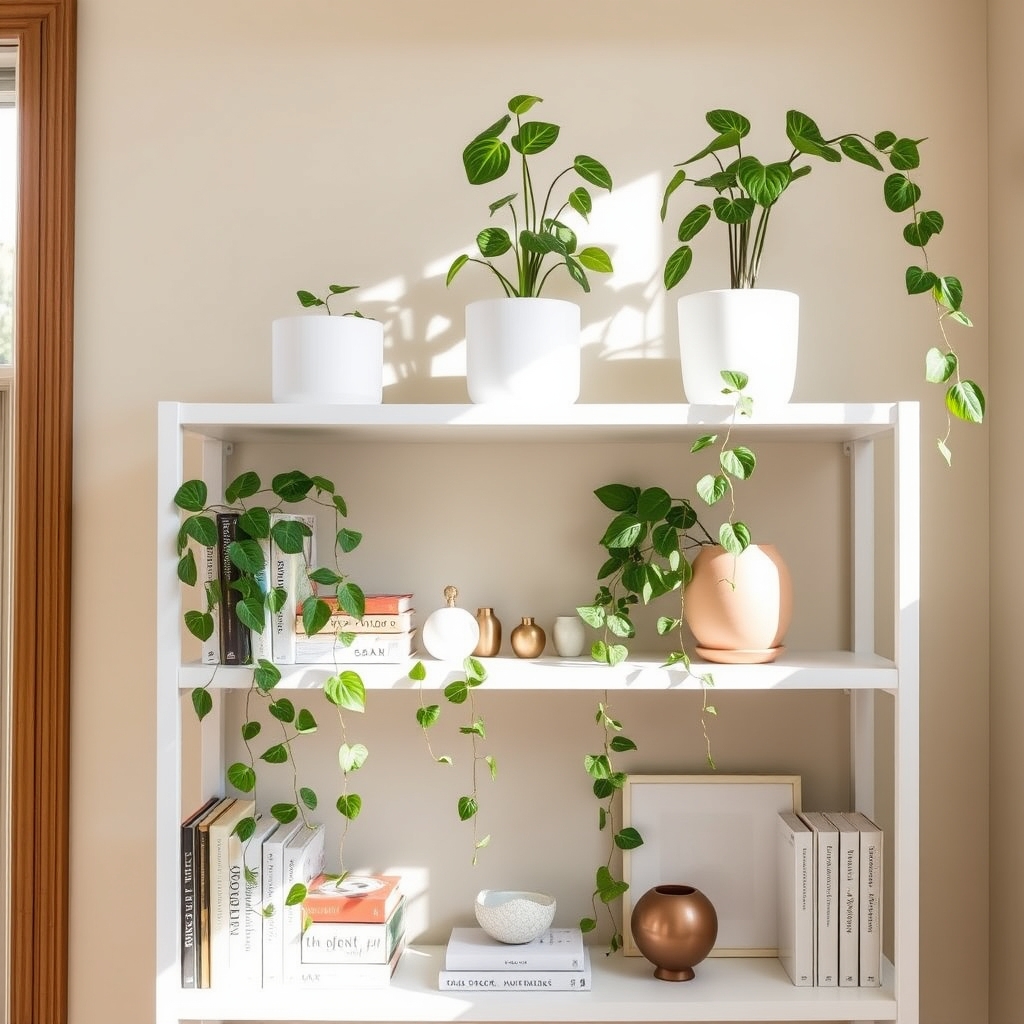
Incorporating there, plant lovers! If you’re looking to add a touch of greenery to your indoor space, incorporating trailing plants on bookshelves is a fantastic idea. These cascading beauties, like pothos, string of pearls, or ivy, can transform a plain shelf into a lush, living display. Place them on higher shelves to let their vines drape down naturally, creating a waterfall effect that adds depth and texture to your room.
To style them effectively, mix trailing plants with your books and decor items for a balanced look. Use small pots or hanging planters that complement your shelf’s aesthetic—think ceramic for a modern vibe or macramé for a boho touch. Make sure the plants get adequate light by positioning the shelf near a window, or opt for low-light-tolerant varieties if natural light is limited.
For an extra pop, experiment with layering by placing shorter plants or objects in front of the trailing ones to create a dynamic, curated feel. Rotate the pots occasionally to encourage even growth and prevent the vines from tangling with your items. With just a little care, your bookshelf can become a green focal point that breathes life into your space!
Use Plant Stands for Height Variation
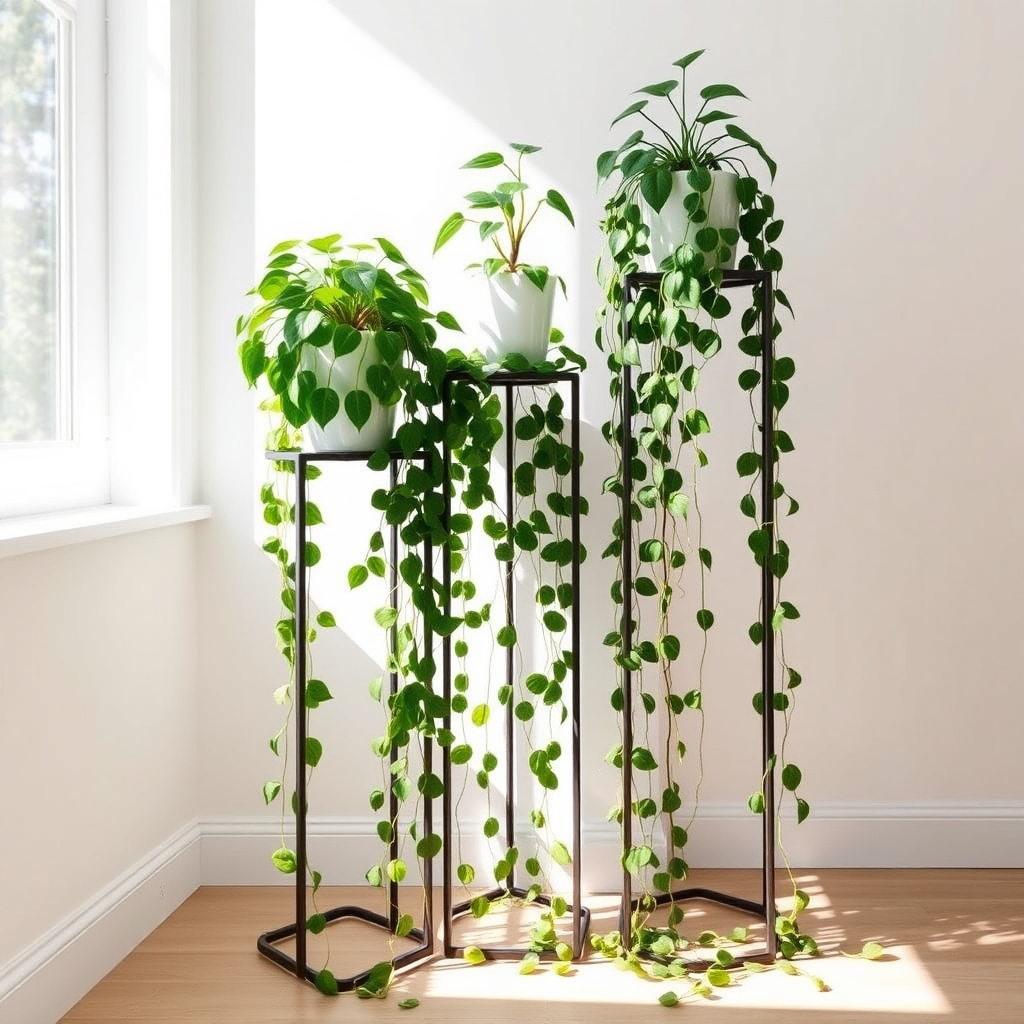
Using plant stands for height variation is an excellent way to style trailing plants indoors, as it adds visual interest and dimension to your space. By elevating some plants on stands of different heights, you can create a layered effect that mimics a natural, cascading landscape. This approach not only highlights the beauty of trailing plants like pothos, string of pearls, or ivy but also prevents your indoor garden from looking flat or monotonous.
Plant stands come in various designs, materials, and sizes, allowing you to match them with your interior decor while showcasing your plants at eye level or above. Positioning trailing plants on taller stands near windows or in corners can draw the eye upward, making the room feel larger and more dynamic. Additionally, height variation helps guarantee that each plant gets adequate light exposure, as taller stands can prevent lower plants from being overshadowed.
For a cohesive look, group multiple stands together in a cluster, mixing heights and pot sizes to create a balanced yet organic display. You can also experiment with hanging trailing plants above the stands to enhance the cascading effect. This method transforms your indoor space into a lush, green haven, full of texture and depth.
Mix Different Textures and Colors
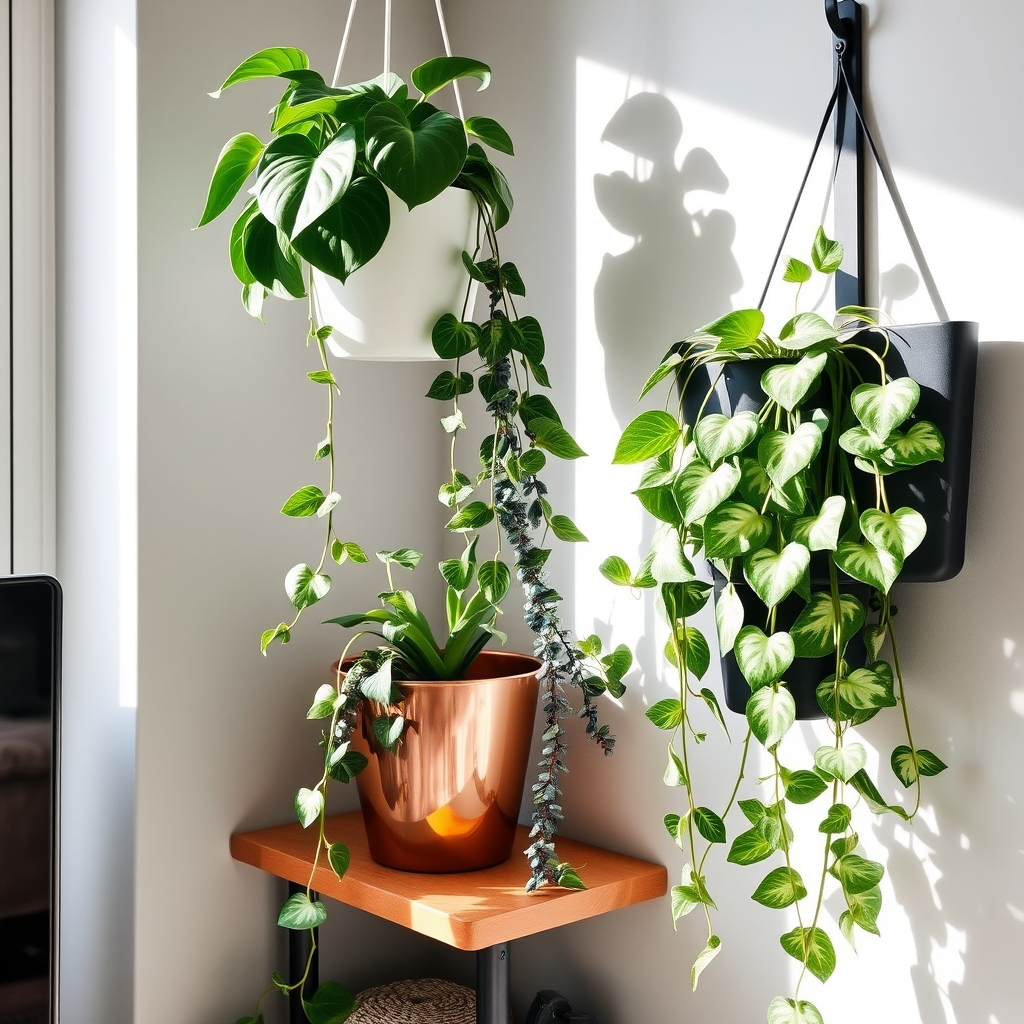
Mixing different textures and colors when styling trailing plants indoors can create a visually dynamic and engaging display. By combining plants with varied leaf shapes, sizes, and hues, you can add depth and interest to your space. For instance, pair the soft, velvety leaves of a trailing begonia with the sleek, glossy vines of a pothos to contrast textures, while incorporating a variegated ivy with creamy white and green tones alongside a deep green philodendron for a striking color play.
This approach not only enhances the aesthetic appeal but also allows each plant to stand out while contributing to a cohesive look. Consider grouping plants with bold, broad leaves like a monstera with finer, delicate trailers such as string of pearls to balance the arrangement. Experimenting with color palettes—such as mixing cool-toned greens with warm burgundy or silver undertones—can evoke different moods, from calming to dramatic, depending on your interior style.
To achieve the best results, place these varied plants at different heights or in complementary containers to emphasize their unique characteristics. Hanging baskets, wall-mounted planters, or tiered stands can help showcase the diversity in texture and color, turning your indoor garden into an enchanting focal point.
Hang Plants From Ceiling Hooks
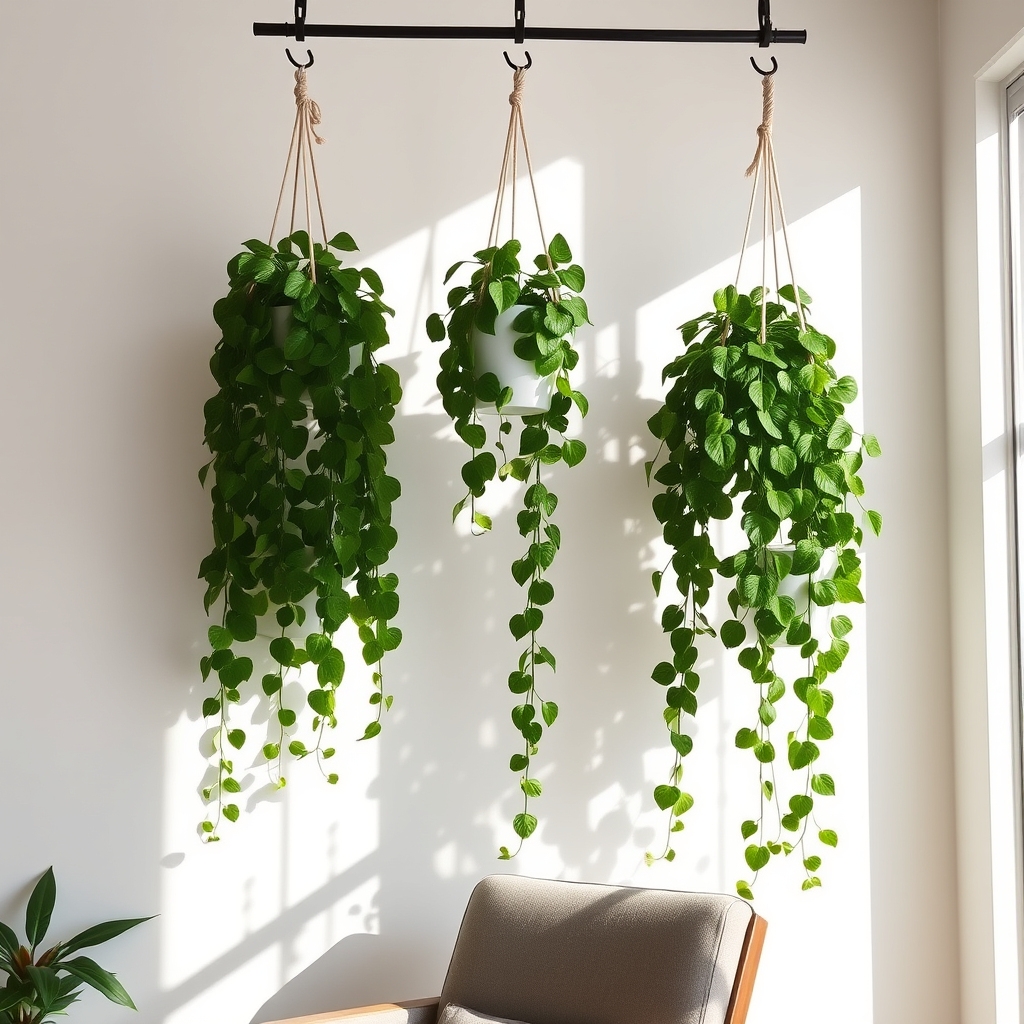
Hanging trailing plants from ceiling hooks is an excellent way to add a touch of greenery to your indoor space while maximizing vertical areas. This method not only saves floor and shelf space but also creates a stunning visual effect as the plants cascade downward. To start, choose a sturdy ceiling hook that can support the weight of your plant, pot, and any additional water weight after watering. Install the hook securely into a ceiling joist or use a toggle bolt for drywall to guarantee safety and stability.
Select trailing plants like pothos, string of pearls, or ivy that thrive in hanging conditions and complement your decor. Use lightweight pots or hanging baskets with proper drainage to prevent water damage to your ceiling or floors. Position the hook in a spot with adequate light for your plant’s needs, and consider using a swivel hook to rotate the plant occasionally for even growth. This setup not only enhances the aesthetic appeal of your room but also keeps trailing plants out of reach of pets or children if needed.
Regularly check the hook and pot for stability, and water your plants carefully to avoid drips. You can also add a drip tray or saucer beneath the pot to catch excess water. Hanging plants from ceiling hooks offers a creative way to display your greenery, turning an ordinary space into a lush, green haven with minimal effort.
Style With Decorative Macrame Hangers

Styling trailing plants indoors with decorative macrame hangers is a beautiful and practical way to elevate your space. Macrame hangers, often handcrafted with intricate knotting techniques, add a bohemian or earthy aesthetic to your home while showcasing your plants at varying heights. These hangers are perfect for trailing varieties like pothos, string of pearls, or ivy, as they allow the vines to cascade naturally, creating a stunning visual effect.
To style with macrame hangers, choose a design that complements your interior decor—whether it’s a minimalist, neutral-toned hanger or one with colorful beads and tassels for a bolder statement. Hang them near windows for ideal light exposure or in corners to draw the eye upward and maximize vertical space. Pairing multiple hangers at different lengths can create a layered, dynamic look that adds depth to your room.
Additionally, macrame hangers are versatile and easy to install with ceiling hooks or wall brackets, making them suitable for renters or those who prefer non-permanent solutions. Make sure the hanger is sturdy enough to support the weight of your pot and plant, especially as they grow. This styling method not only highlights the beauty of your trailing plants but also transforms them into living art pieces within your home.
Place on High Furniture for Drama

Placing trailing plants on high furniture is an excellent way to create a dramatic and eye-catching display in your indoor space. By positioning plants like pothos, string of pearls, or ivy on top of tall bookshelves, cabinets, or wall-mounted shelves, you allow their cascading vines to flow downward, drawing the eye and adding a sense of movement to the room. This placement not only highlights the natural beauty of the plant’s trailing growth but also transforms an otherwise empty vertical space into a lush, living feature.
This styling technique works particularly well in rooms with high ceilings, where the vertical drop of the vines can be fully appreciated. It also helps to keep the trailing foliage out of the way, preventing it from cluttering lower surfaces or getting tangled. To enhance the drama, consider using a mix of trailing plants with varying leaf shapes, colors, and textures, creating a layered, dynamic look that adds depth to your decor.
For safety and stability, make sure that the furniture is sturdy and the plant pots are secure to avoid any accidents. You can also use hanging planters or macramé holders attached to the furniture to add an extra bohemian flair. This elevated placement not only maximizes space but also turns your trailing plants into a stunning focal point in any room.
Group Plants for a Lush Effect

Grouping trailing plants together can create a lush, vibrant effect that transforms any indoor space into a green oasis. By clustering plants with varying textures, colors, and lengths of vines, you can achieve a dynamic and layered look that mimics a natural jungle setting. Place them on a shelf, in a corner, or on a plant stand to allow their cascading foliage to intermingle, adding depth and visual interest to the area.
When grouping, consider using pots of different heights or hanging some plants while placing others on surfaces to create a sense of movement. This arrangement not only maximizes the aesthetic impact but also makes it easier to care for your plants since they are in close proximity for watering and maintenance. Make sure that the grouped plants have similar light and humidity needs to keep them thriving together.
Experiment with combinations like pairing a pothos with a string of pearls or a trailing philodendron with a spider plant for a striking contrast. Position the group near a window with filtered light to highlight their beauty and encourage healthy growth. This approach turns a simple collection of plants into a cohesive, eye-catching display that enhances the overall ambiance of your home.
